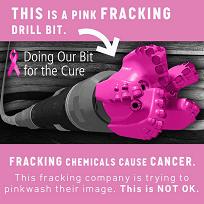
DCS Letter to Susan G. Komen re: Fracking
October 11, 2014PA DEP Admits Drilling Probe Error in Range Inquiry
October 17, 2014See the 2011 Congressional Report Below
Although Baker Hughes, Inc. has received kudos for promising to disclose at FracFocus.org, “all the chemicals” they use in gas extraction, questions about the value of the promise are being raised.
In March 2014, the US Department of Energy’s (DOE) own advisory board report raised several concerns about FracFocus.org’s efficacy:
“At present the modest (< $1 million) budget for FracFocus is covered by a DOE grant, occasional contributions from a state, and from two oil and gas industry associations…. A large fraction of reporting wells claim at least one trade secret exemption. The Task Force favors full disclosure of all known constituents added to fracturing fluid with few, if any exceptions” and recommended, “… improving the accuracy and completeness of registry submissions… an independent audit to assess the accuracy and compliance of the process will be useful for all stakeholders.”
Damascus Citizens for Sustainability further warns that all disclosures should be reviewed in light of a little-known 2011 Congressional report (below) which found that of the 750 compounds used by 14 major fracking companies, 650 contained chemicals that are known or potential human carcinogens, regulated under the Safe Drinking Water Act for their risks to human health, or listed as hazardous air pollutants under the Clean Air Act.
For more on fracking chemicals, the gutting of Federal environmental protections, worker health and threats to it, see DCS’ “What They Knew in 1988“, and the 2011 Minority Congressional report (below).
If you are a GasVet worker or a resident of “Gasland” and believe you’ve suffered harm from gas extraction, production or related activities, start taking control. Participate in DCS’ Health and Community Impacts Survey!
UNITED STATES HOUSE OF REPRESENTATIVES
COMMITTEE ON ENERGY AND COMMERCE
MINORITY STAFF
APRIL 2011
Executive Summary
Download the full Report as a pdf
Hydraulic fracturing has helped to expand natural gas production in the United States, unlocking large natural gas supplies in shale and other unconventional formations across the country. As a result of hydraulic fracturing and advances in horizontal drilling technology, natural gas production in 2010 reached the highest level in decades. According to new estimates by the Energy Information Administration (EIA), the United States possesses natural gas resources sufficient to supply the United States for approximately 110 years.
As the use of hydraulic fracturing has grown, so have concerns about its environmental and public health impacts. One concern is that hydraulic fracturing fluids used to fracture rock formations contain numerous chemicals that could harm human health and the environment, especially if they enter drinking water supplies. The opposition of many oil and gas companies to public disclosure of the chemicals they use has compounded this concern.
Last Congress, the Committee on Energy and Commerce launched an investigation to examine the practice of hydraulic fracturing in the United States. As part of that inquiry, the Committee asked the 14 leading oil and gas service companies to disclose the types and volumes of the hydraulic fracturing products they used in their fluids between 2005 and 2009 and the chemical contents of those products. This report summarizes the information provided to the Committee.
Between 2005 and 2009, the 14 oil and gas service companies used more than 2,500 hydraulic fracturing products containing 750 chemicals and other components. Overall, these companies used 780 million gallons of hydraulic fracturing products – not including water added at the well site – between 2005 and 2009.
Some of the components used in the hydraulic fracturing products were common and generally harmless, such as salt and citric acid. Some were unexpected, such as instant coffee and walnut hulls. And some were extremely toxic, such as benzene and lead. Appendix A lists each of the 750 chemicals and other components used in hydraulic fracturing products between 2005 and 2009.
The most widely used chemical in hydraulic fracturing during this time period, as measured by the number of compounds containing the chemical, was methanol. Methanol, which was used in 342 hydraulic fracturing products, is a hazardous air pollutant and is on the candidate list for potential regulation under the Safe Drinking Water Act. Some of the other most widely used chemicals were isopropyl alcohol (used in 274 products), 2-butoxyethanol (used in 126 products), and ethylene glycol (used in 119 products).
Between 2005 and 2009, the oil and gas service companies used hydraulic fracturing products containing 29 chemicals that are (1) known or possible human carcinogens, (2) regulated under the Safe Drinking Water Act for their risks to human health, or (3) listed as hazardous air pollutants under the Clean Air Act. These 29 chemicals were components of more than 650 different products used in hydraulic fracturing.
The BTEX compounds – benzene, toluene, xylene, and ethylbenzene – appeared in 60 of the hydraulic fracturing products used between 2005 and 2009. Each BTEX compound is a regulated contaminant under the Safe Drinking Water Act and a hazardous air pollutant under the Clean Air Act. Benzene also is a known human carcinogen. The hydraulic fracturing companies injected 11.4 million gallons of products containing at least one BTEX chemical over the five year period.
In many instances, the oil and gas service companies were unable to provide the Committee with a complete chemical makeup of the hydraulic fracturing fluids they used. Between 2005 and 2009, the companies used 94 million gallons of 279 products that contained at least one chemical or component that the manufacturers deemed proprietary or a trade secret. Committee staff requested that these companies disclose this proprietary information. Although some companies did provide information about these proprietary fluids, in most cases the companies stated that they did not have access to proprietary information about products they purchased “off the shelf” from chemical suppliers. In these cases, the companies are injecting fluids containing chemicals that they themselves cannot identify.



